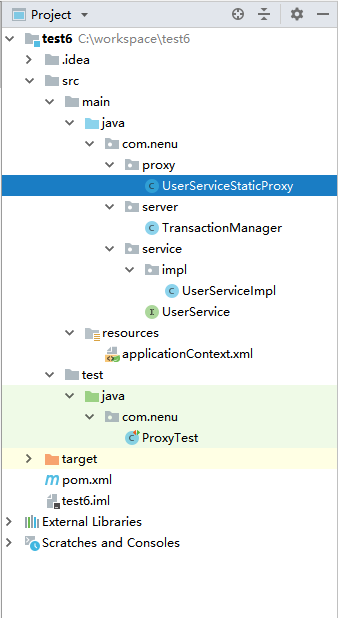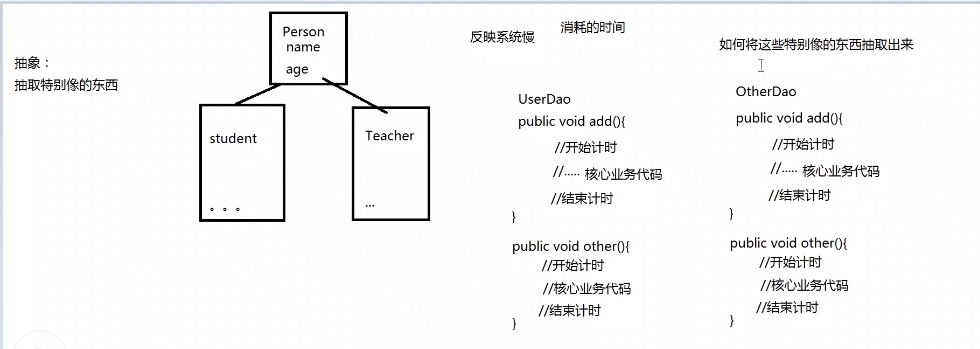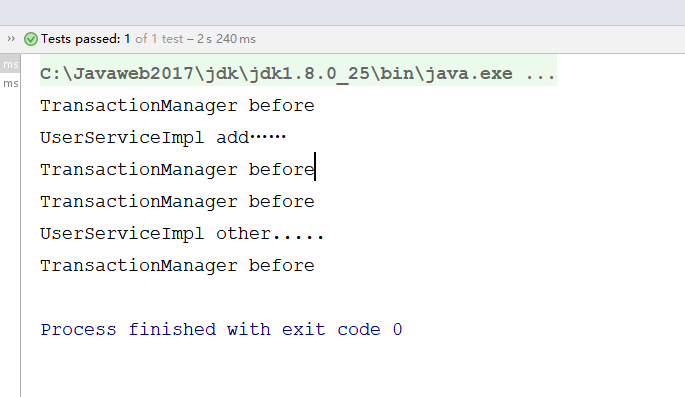Spring AOP - 静态代理实践
说明
如图项目目录,以下所有操作对应此项目目录:

如图,根据SpringAOP的原理,使用静态代理抽取其中特别像的方法add()和other()

一、xml类中配置全注解:
<?xml version="1.0" encoding="UTF-8"?> <beans xmlns="http://www.springframework.org/schema/beans" xmlns:xsi="http://www.w3.org/2001/XMLSchema-instance" xmlns:context="http://www.springframework.org/schema/context" xsi:schemaLocation="http://www.springframework.org/schema/beans http://www.springframework.org/schema/beans/spring-beans-3.0.xsd http://www.springframework.org/schema/context https://www.springframework.org/schema/context/spring-context.xsd"> <!-- 开启扫描 --> <context:component-scan base-package="com.nenu"/> </beans>
二、UserService类:
编辑add和other方法的接口
package com.nenu.service; public interface UserService { public void add(); public void other(); }
三、UserServiceImpl类
编辑add和other方法的继承类,这两个方法主要是输出一句话:
package com.nenu.service.impl; import com.nenu.service.UserService; import org.springframework.stereotype.Component; @Component public class UserServiceImpl implements UserService { @Override public void add() { System.out.println("UserServiceImpl add……"); } @Override public void other() { System.out.println("UserServiceImpl other....."); } public UserServiceImpl(){} }
四、TransactionManager(事务管理类)
在事务管理类TransactionManager中设置add和other方法前后的事务管理before和after(非核心代码)
package com.nenu.server; public class TransactionManager { //before public void before(){ System.out.println("TransactionManager before"); } //after public void after(){ System.out.println("TransactionManager before"); } }
PS:这里面的方法也可以写静态的,这样后面就不用new对象了
事务管理详见:Spring 事务管理详解
五、UserServiceStaticProxy
package com.nenu.proxy; import com.nenu.server.TransactionManager; import com.nenu.service.UserService; public class UserServiceStaticProxy implements UserService { //目标对象 - 代理谁 private UserService target; //要加入的业务增强,比如记录时间,加入事务控制 private TransactionManager transactionManager; //通过构造方法来传入具体要代理的对象 public UserServiceStaticProxy(UserService target, TransactionManager transactionManager){ this.target = target; this.transactionManager = transactionManager; } @Override public void add() { //非核心业务1 transactionManager.before(); //核心活,目标对象来做 target.add(); //非核心业务2 transactionManager.after(); } @Override public void other() { //非核心业务1 transactionManager.before(); //核心活,目标对象来做 target.other(); //非核心业务2 transactionManager.after(); } }
六、测试类:
package com.nenu; import com.nenu.proxy.UserServiceStaticProxy; import com.nenu.server.TransactionManager; import com.nenu.service.UserService; import org.junit.Test; import org.springframework.context.ApplicationContext; import org.springframework.context.support.ClassPathXmlApplicationContext; public class ProxyTest { @Test public void UserTest(){ //1.配置容器 ApplicationContext applicationContext = new ClassPathXmlApplicationContext("applicationContext.xml"); //2.取出容器中bean UserService target = (UserService) applicationContext.getBean("userServiceImpl"); //3.创建一个代理对象 //3.1 创建非核心业务增强对象 TransactionManager transactionManager = new TransactionManager(); //3.2 创建代理对象 UserServiceStaticProxy proxy = new UserServiceStaticProxy(target, transactionManager); //3.调用 proxy.add(); proxy.other(); } }
测试:

成功!!!

创建代理模式的方法分为静态代理和动态代理,静态代理的对象是要实实在在创造出来的,静态代理在编译期就决定了。
原理上图↑↑↑,小伙伴们加油


 浙公网安备 33010602011771号
浙公网安备 33010602011771号